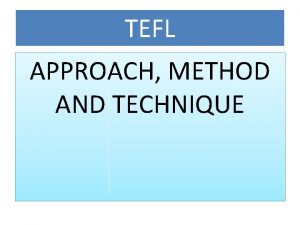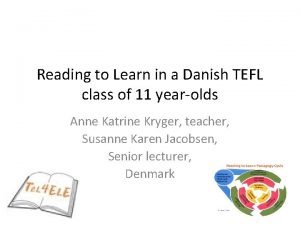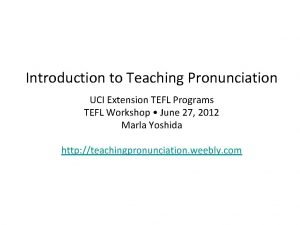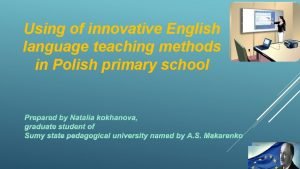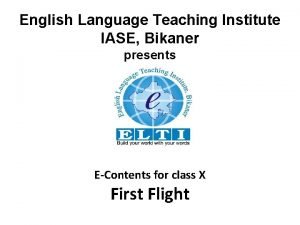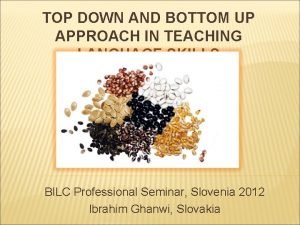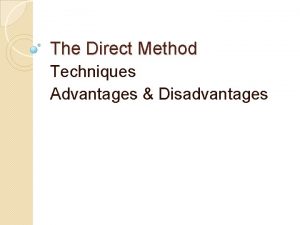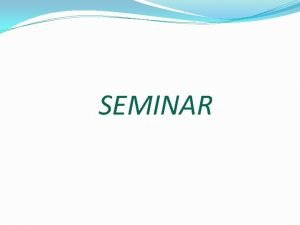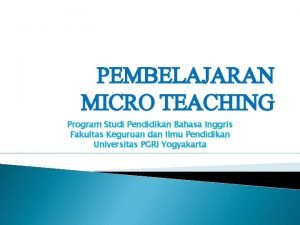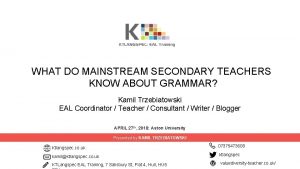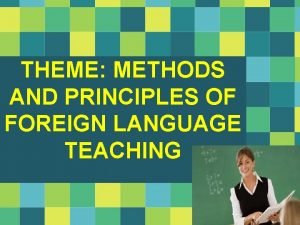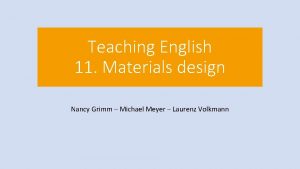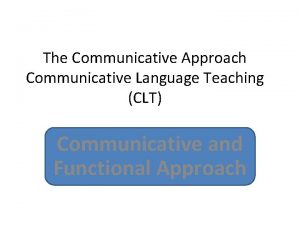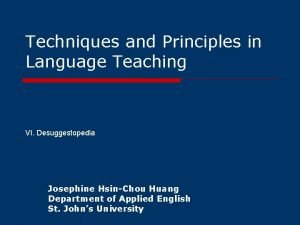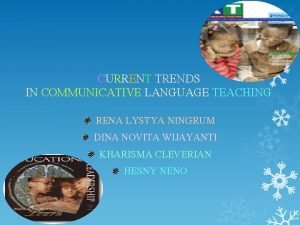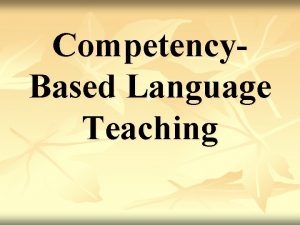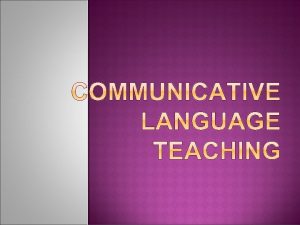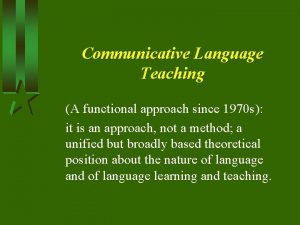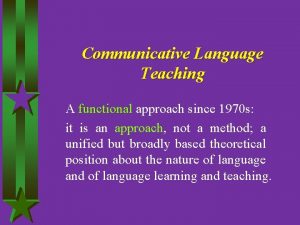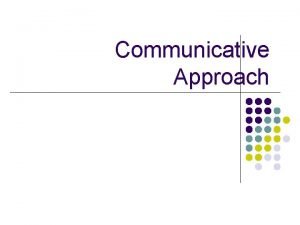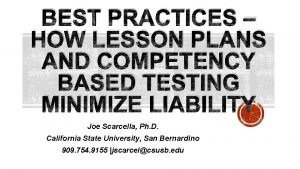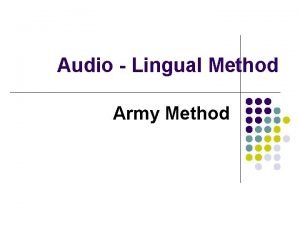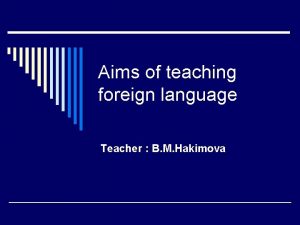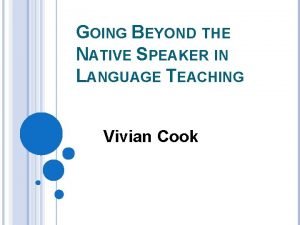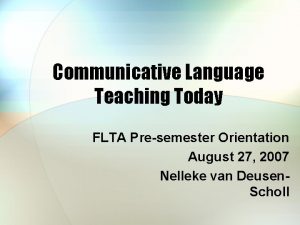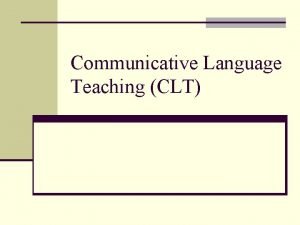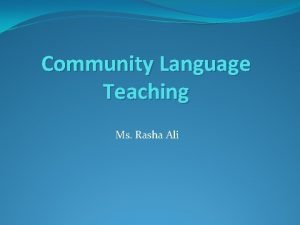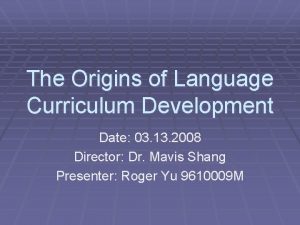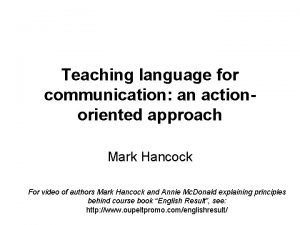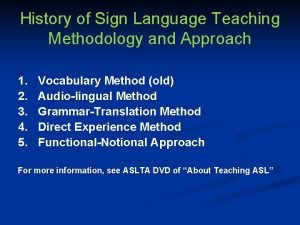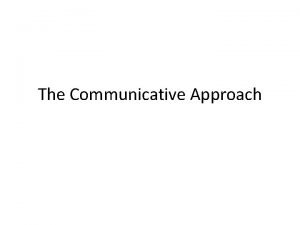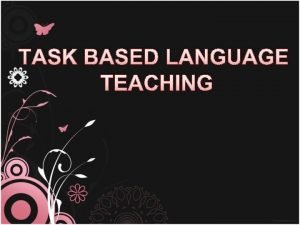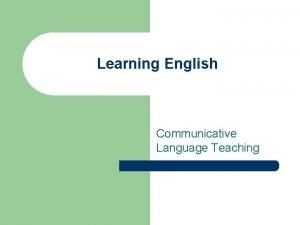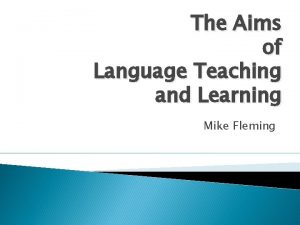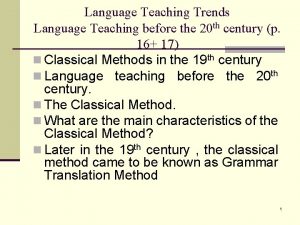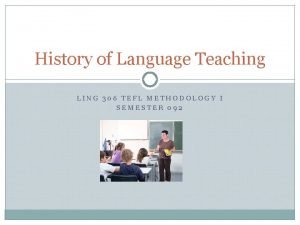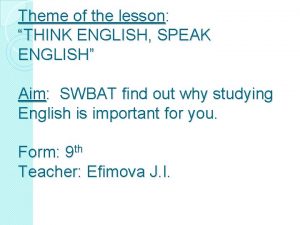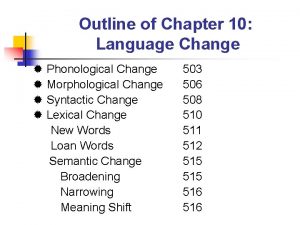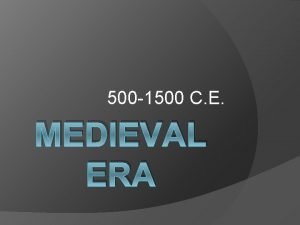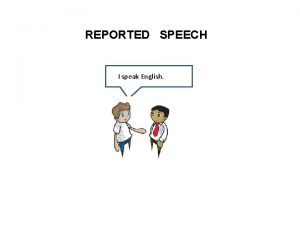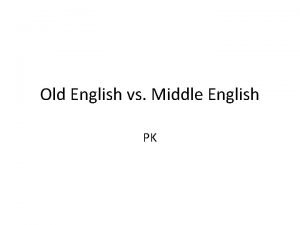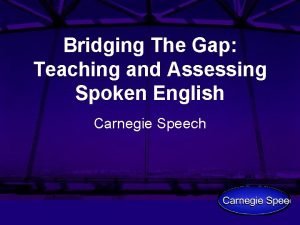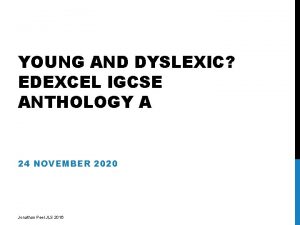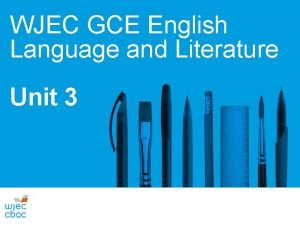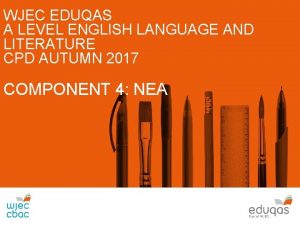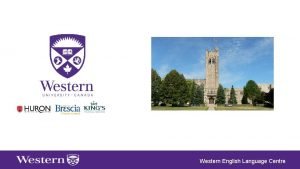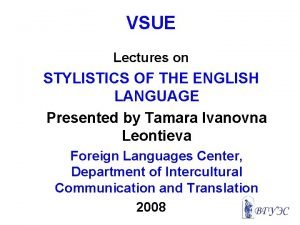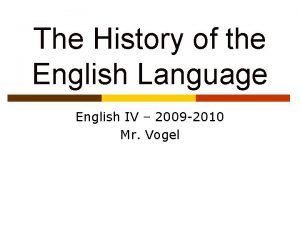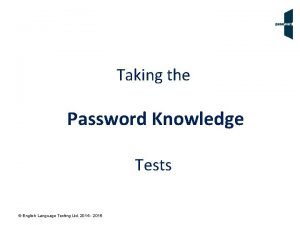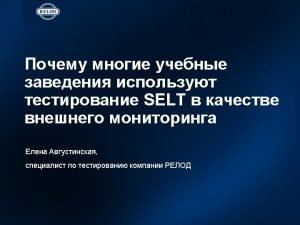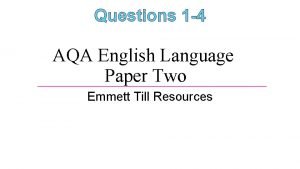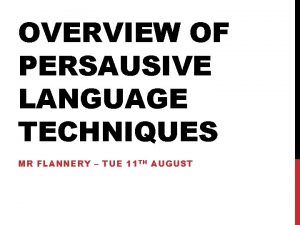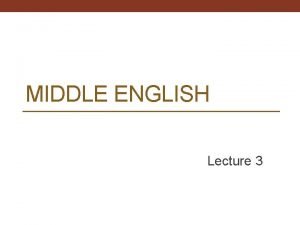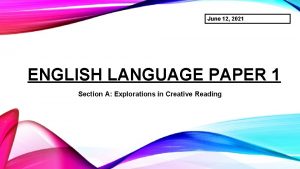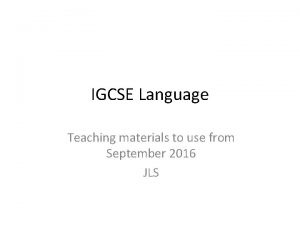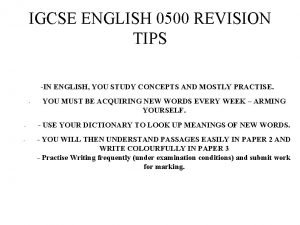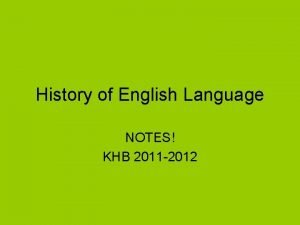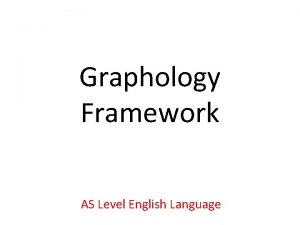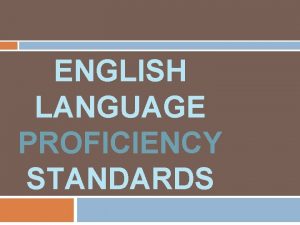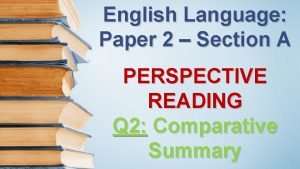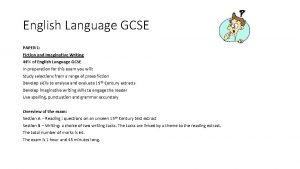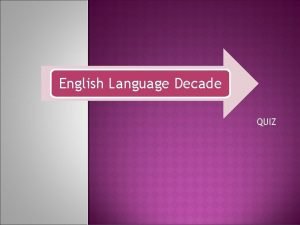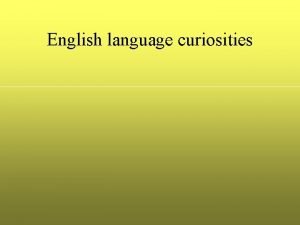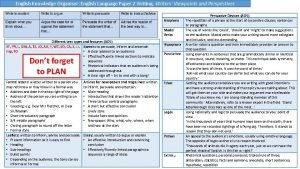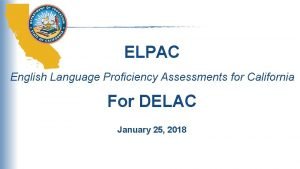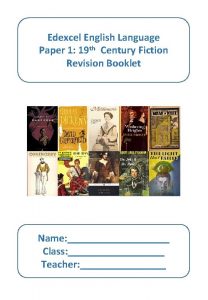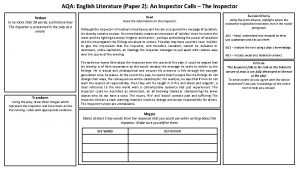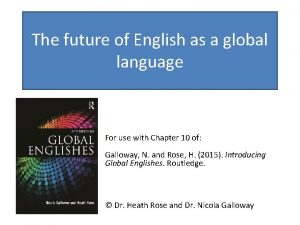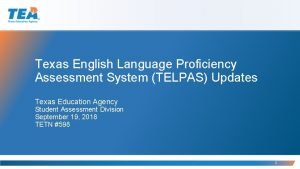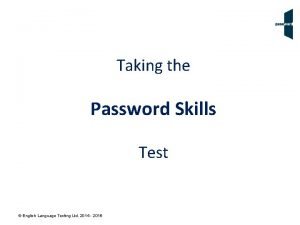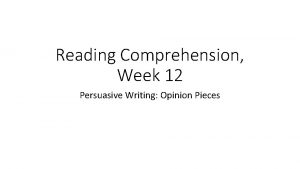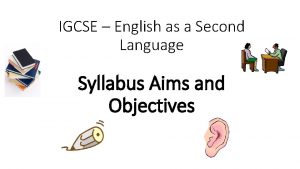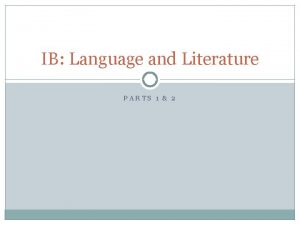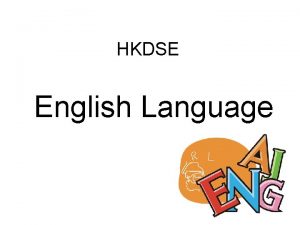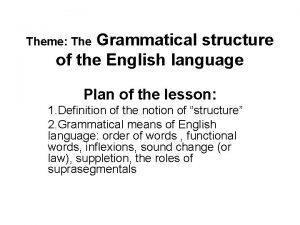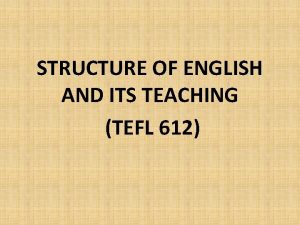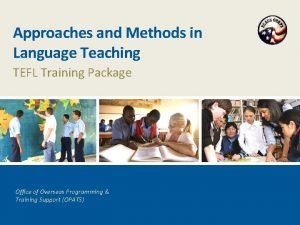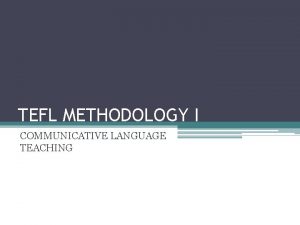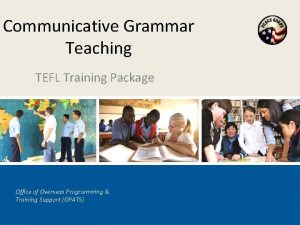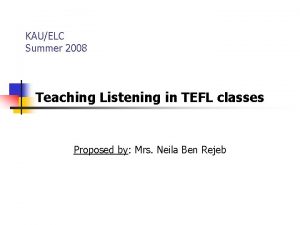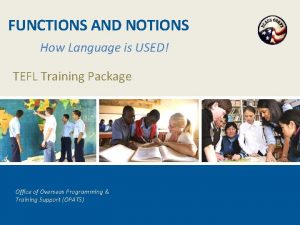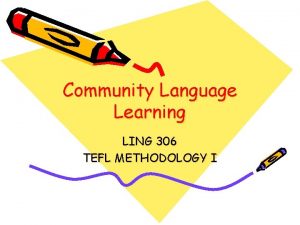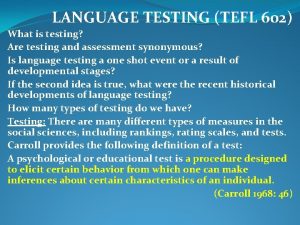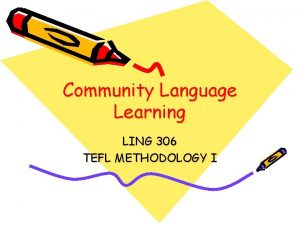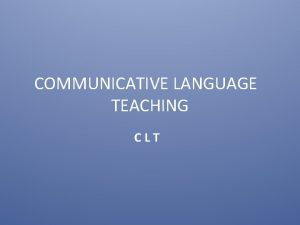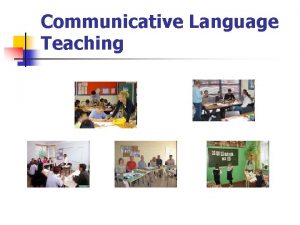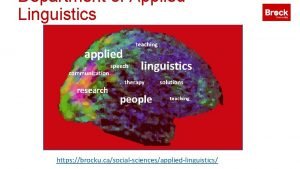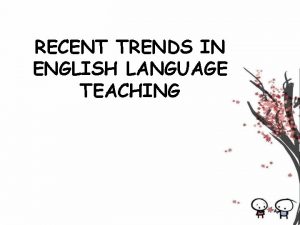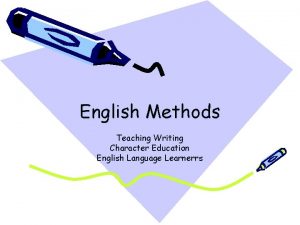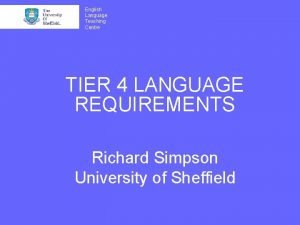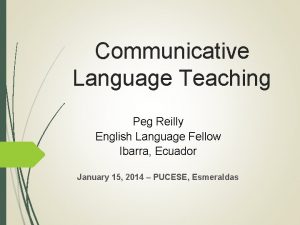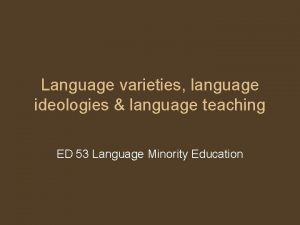TEACHING ENGLISH AS A FOREIGHN LANGUAGE TEFL Applied































































































































- Slides: 127

TEACHING ENGLISH AS A FOREIGHN LANGUAGE (TEFL) Applied Linguistics Master’s Program Instructor: Dr. Sadek FIrwana 1 st Semester 2015 -2016

What is applied linguistics? Applied linguistics is an area of work that deals with language use in professional settings, translation, speech pathology, literacy, and language education. It is not merely the application of linguistic knowledge to such settings but is a semiautonomous and interdisciplinary domain of work that draws on but is not dependent on areas such as sociology, education, anthropology, cultural studies, and psychology. “

Approaches, methods, procedures, and techniques • Approach refers to theories about the nature of language and language learning that serve as the source of practices and principles in language teaching. .

Approaches, methods, procedures, and techniques • Approach refers to the beliefs and theories about language, language learning and teaching that underlie a method.

Approaches, methods, procedures, and techniques • An approach describes how people acquire their knowledge of the language and makes statements about conditions which will promote successful language learning.

Approaches, methods, procedures, and techniques • Method : a method is the practical realization of an approach. • Method is “an umbrella term for the specification and interrelation of theory and practice” • Methods include various procedures and techniques as part of their standard fare.

Approaches, methods, procedures, and techniques • Procedure : a procedure is an ordered sequence of techniques. A procedure is a sequence which can be described in terms such as first you do this, then you do that… • A procedure is smaller than a method and bigger than technique.

• Technique : Specific activities manifested in the classroom that are consistent with a method and therefore in harmony with an approach

• A common technique when using video material is called “silent viewing”. This is where the teacher plays the video with no sound. Silent viewing is a single activity rather than a sequence, and as such is a technique rather than a whole procedure.

Approach A set of assumptions dealing with the nature of language, learning, and teaching Method An overall plan for systematic presentation of language based upon a selected approach Procedure An ordered sequence of techniques. It is smaller than a method and bigger than a technique. Technique Specific activities manifested in the classroom that are consistent with a method and therefore in harmony with an approach

The Grammar- Translation Method (GTM) GTM was originally used to teach Latin and Greek. It was used by language teachers to help students read and appreciate foreign language literature.

The Grammar- Translation Method (GTM) It was believed that students would have a complete command of the grammar of the native language through the study of the grammar of the target language. Thus, this would help them speak and write better in their native language.

The Grammar- Translation Method (GTM) Finally, it was thought that a) learning a foreign language would help students grow intellectually, and b) the mental exercise of learning would be beneficial although they would probably never use the target language.

The Grammar- Translation Method (GTM) GTM was later highly criticized for conceiving grammar as an end, not as a means. The biggest weakness was that the aesthetics of the language was generally ignored due to its negligence of the functional aspects of the language.

The Grammar- Translation Method (GTM) Key Principles: 1) Classes are taught in the mother tongue, with little active use of the target language. 2) Much vocabulary is taught in the form of lists of isolated words. 3) Long elaborate explanations of the intricacies of grammar are given. 4) Grammar provides the rules for putting words together, and instruction often focuses on the form and inflection of words.

The Grammar- Translation Method (GTM) 5) Reading the difficult classical texts is begun early. 6) Little attention is paid to the content of texts, which are treated as exercises in grammatical analysis. 7) Often the only drills are the exercises in translating disconnected sentences from the target language into the mother tongue. 8) Little or no attention is given to pronunciation.

The Grammar- Translation Method (GTM) Key Techniques: 1) Translation of a Literary Passage (Translating from target language to native language) 2) Reading Comprehension Questions (Finding information in a passage, making inferences and relating to personal experience) 3) Antonyms/Synonyms (Finding antonyms and synonyms for words or sets of words).

The Grammar- Translation Method (GTM) 4) Cognates (Learning spelling/sound patterns that correspond between L 1 and the target language) 5) Deductive Application of Rule (Understanding grammar rules and their exceptions, then applying them to new examples) 6) Fill-in-the-blanks (Filling in gaps in sentences with new words or items of a particular grammar type).

The Grammar- Translation Method (GTM) 7) Memorization (Memorizing vocabulary lists, grammatical rules and grammatical paradigms) 8) Use of Words in Sentences (Students create sentences to illustrate that they know the meaning and the use of new words) 9) Composition (Students write about a topic using the target language)

The Direct Method (DM) This method came into use when teachers thought that learning how to use a foreign language for the purpose of communication was the goal of instruction. DM became very popular when the GTM was not found effective in preparing students to use the target language communicatively the way we learn our target language.

The Direct Method (DM) Contrary to GTM, no translation is allowed in the classroom. Through the use of visual aids and demonstrations meaning is conveyed in the target language without using the native language.

The Direct Method (DM) Key Principles: 1) Classroom instruction is conducted exclusively in the target language. 2) Only everyday vocabulary and sentences are taught. 3) Oral communication skills are built up in a careful progression organized around questions-and-answer exchanging between teachers and students in small intensive classes. 4) Grammar is taught inductively.

The Direct Method (DM) 5) New teaching points are taught through modeling and practice 6) Concrete vocabulary is taught through demonstration, objects, pictures; abstract vocabulary is taught through association of ideas. 7) Both speech and listening comprehension are taught. 8) Correct pronunciation and grammar are emphasized.

The Direct Method (DM) Key techniques: 1) Lessons begin with a dialogue using a modern conversational style in the target language. 2) Material is first presented orally with actions or pictures. 3) The mother tongue is never used. There is no translation. 4) The preferred type of exercise is a series of questions in the target language based on the dialogue or an anecdotal narrative.

The Direct Method (DM) 5) Questions are answered in the target language. 6) Grammar is taught inductively—rules are generalized from the practice and experience with the target language. 7) Verbs are used first and systematically conjugated much later after some oral mastery of the target language.

The Direct Method (DM) 8) Advanced students read literature for comprehension and pleasure. 9) Literary texts are not analyzed grammatically. 10) The culture associated with the target language is also taught inductively.

The Audio-Lingual Method (ALM) The Audio-Lingual Method is basically an oral-based approach like DM. However, it differs from DM in many respects. First, while DM emphasizes vocabulary acquisition through exposure to its use in situations, ALM drills students in the use of grammatical sentence patterns.

The Audio-Lingual Method (ALM) Secondly, ALM has a strong theoretical base in linguistics and psychology. Most of the principles of behavioral psychology were incorporated into this method.

The Audio-Lingual Method (ALM) It is for this reason that the sentence patterns of the target language are thought to be acquired through conditions which mean to respond correctly to stimuli through shaping and reinforcement. Learners overcome the habits of their native language and form new habits in order to be target language speakers.

The Audio-Lingual Method (ALM) Key Principles: 1) This method is based on the principles of behavior psychology. 2) It adapted many of the principles and procedures of the Direct Method, in part as a reaction to the lack of speaking skills of the Reading Approach. 3) New material is presented in the form of a dialogue. 4) Based on the principle that language learning is habit formation, the method fosters dependence on mimicry, memorization of set phrases and over-learning.

The Audio-Lingual Method (ALM) 5) Structures are sequenced and taught one at a time. Structural patterns are taught using repetitive drills. 6) Little or no grammatical explanations are provided; grammar is taught inductively. 7) Skills are sequenced: Listening, speaking, reading and writing are developed in order. 8) Vocabulary is strictly limited and learned in context. 9) Teaching points are determined by contrastive analysis between L 1 and L 2.

The Audio-Lingual Method (ALM) Key Techniques: 1) Make sure that all of the utterances which students will make are actually within the practiced pattern. For example, the use of the AUX verb “have” should not suddenly switch to have’ as a main verb. 2) Conduct the drills as rapidly as possible so as to insure automaticity and to establish a system. 3) Ignore all but gross errors of pronunciation when drilling for grammar practice.

The Audio-Lingual Method (ALM) 4) Use the shortcuts to keep the pace of drills at a maximum. Use hand motions, signal cards, notes, etc. to cue response. You are a choir director. 5) Use normal English stress, intonation, and juncture patterns conscientiously. 6) Make sure that the drill material should always be meaningful. If the content words are not known, teach their meanings. 7) Intersperse short periods of drill (about 10 minutes) with very brief alternative activities to avoid fatigue and boredom.

The Audio-Lingual Method (ALM) 8) Introduce the drill in this way: a. Focus (by writing on the board, for example) b. Exemplify (by speaking model sentences) c. Explain (if a simple grammatical explanation is needed) d. Drill 9) Don’t stand in one place; move about the room standing next to as many different students as possible to spot check their production. Thus you will know who to give more practice to during individual drilling.

The Audio-Lingual Method (ALM) 10) Use the “backward buildup” technique for long and/or difficult patterns. — tomorrow — in the cafeteria tomorrow — will be eating in the cafeteria tomorrow — Those boys will be eating in the cafeteria tomorrow. 11) Arrange to present drills in the order of increasing complexity of student response. The question is: How much internal organization or decision making must the student do in order to make a response in this drill. Thus: imitation first, single-slot substitution next, then free response last.

Presentation, Practice, and Production • A variation on ALM in Britishbased teaching and elsewhere is the procedure most often referred to as PPP, which stands for Presentation, Practice, and Production.

Presentation, Practice, and Production • In PPP the teacher introduces a situation which contextualises the language to be taught. The students now practice the language using accurate reproduction techniques such as choral repetition, individual repetition, and cue-response drills

PPP and alternatives to PPP • The PPP procedure came under a sustained attack in the 1990 s. • Michael Lewis suggested that PPP was inadequate because it reflected neither the nature of language nor the nature of learning.

PPP and alternatives to PPP • Jim Scrivener advanced what is perhaps the most worrying aspect of PPP, the fact that it only describes one kind of lesson; it is inadequate as a general proposal concerning approaches to language in the classroom. • In response to these criticisms many people have offered variations on PPP and alternatives to it: ARC, OHE/III, ESA.

ARC • put forward by Jim Scrivener • stands for Authentic use, Restricted use and Clarification and focus • Communicative activity will demonstrate authentic use; elicited dialogue or guided writing will provoke restricted use of language by students; finally clarification language is that which the teacher and students use to explain grammar, give examples, analyse errors, elicit or repeat things.

OHE/III • Michael Lewis claims that students should be allowed to Observe (read or listen to language) which will then provoke them to Hypothesise about how the language works before going on to the Experiment on the basis of that hypothesis.

ESA • In the ESA model three components will usually be present in any teaching sequence, whether of five, fifty or a hundred minutes • E stands for Engage - students have to be engaged emotionally • S stands for Study • A stands for Activate - any stage at which students are encouraged to use all and/or any of the language they know

The Silent Way (SW) One problem with ALM that students had difficulty in transferring the habits they had mastered in the classroom to communicative use outside it challenged the idea that learning a language meant forming a set of habits. Linguist Chomsky proposed that speakers have a knowledge of underlying abstract rules, by which they understand create novel utterances.

The Silent Way (SW) Thus, language learning is no longer considered a product of habit formation, but rather of rule formation. Accordingly, acquiring a language is a procedure whereby people use their own thinking process, or cognition, to discover the rules of the language they are learning.

The Silent Way (SW) Cognitive Approach appeared as a result of this emphasis on human cognition. In this approach, learners were more actively responsible for their own learning and hypothesizing the formulas in order to discover the rules of the target language. Errors were inevitable and they were signs that learners were actively testing their hypotheses.

The Silent Way (SW) SW developed by Caleb Gattegno shares certain principles of the Cognitive Approach. Gattegno believed that learning a language is a process just as babies and young children learn a language. In this process we mobilize our inner resources such as our perception, awareness, cognition, imagination, intuition, creativity, etc. While we learn a language, we integrate anything “new” into ourselves, and use it for further learning.

The Silent Way (SW) Key Principles: This method begins by using a set of colored wooden rods and verbal commands in order to achieve the following: 1) To avoid the use of the vernacular=mother tongue. 2) To create simple linguistic situations that remain under the complete control of the teacher. 3) To pass on to the learners the responsibility for the utterances of the descriptions of the objects shown or the actions performed. 4) To let the teacher concentrate on what the students say and how they are saying it, drawing their attention to the differences in pronunciation and the flow of words.

The Silent Way (SW) Key Techniques: 1. Sound-Color Chart (The teacher refers students to a color-coded wall chart depicting individual sounds in the target language - students use this to point out and build words with correct pronunciation) 2. Teacher’s Silence (Teacher is generally silent, only giving help when it is absolutely necessary) 3. Peer Correction (Students are encouraged to help each other in a cooperative and not competitive spirit)

The Silent Way (SW) 4. Rods (Rods are used to trigger meaning, and to introduce or actively practice language. They can symbolize whatever words are being taught and be manipulated directly or abstractly to create sentences) 5. Self-correction Gestures (Teacher uses hands to indicate that something is incorrect or needs changing – e. g. using fingers as words then touching the finger/word that is in need of correction) 6. Word Chart (Words are depicted on charts, the sounds in each word corresponding in color to the Sound-Color)

The Silent Way (SW) 7. Fidel Chart (A chart that is color-coded according to the sound-color chart but includes the various English spellings so that they can be directly related to actual sounds) 8. Structured Feedback (Students are invited to make observations about the day’s lesson and what they have learned)

Desuggestopedia Suggestopedia is a teaching method developed by the Bulgarian psychotherapist Georgi Lozanov. The method has been used in different fields of studies but mostly in the field of foreign language learning.

Desuggestopedia Lozanov claimed that by using this method one can teach languages approximately three to five times as quickly as conventional methods.

Desuggestopedia Lozanov asserts that language learning can occur at a much faster rate if we help students remove their psychological barriers to learning which cause their inefficiency. This fear of failure hinders the full use of mental powers that we have. Losanov says that we make use of only five to ten percent of our mental capacity.

Desuggestopedia When the limitations to learning are “desuggested”, we can make better use of our reserved capacity. Desuggestopedia which can be defined as the application of the study of suggestion to pedagogy helps students eliminate the feeling that they cannot be successful and, thus, overcome the barriers to learning. In this method the integration of the fine arts stimulates mental reserves and accelerated learning occurs.

Desuggestopedia Key Principles: 1) Learning is facilitated in an environment that is as comfortable as possible, featuring soft cushioned seating and dim lighting. 2) “Peripheral” learning is encouraged through the presence in the learning environment of posters and decorations featuring the target language and various grammatical information. The teacher assumes a role of complete authority and control in the classroom. 4) Self-perceived and psychological barriers to learners’ potential to learn are “desuggested”.

Desuggestopedia 5) Students are encouraged to be child-like, take “mental trips with the teacher” and assume new roles and names in the target language in order to become more “suggestible”. 6) Baroque music is played softly in the background to increase mental relaxation and potential to take in and retain new material during the lesson. 7) Students work from lengthy dialogs in the target language, with an accompanying translation into the students’ native language.

Desuggestopedia 8) Errors are tolerated, the emphasis being on content and not structure. Grammar and vocabulary are presented and given treatment from the teacher, but not dwelt on. 9) Homework is limited to students re-reading the dialog they are studying – once before they go to sleep at night and once in the morning before they get up. 10) Music, drama and “the Arts” are integrated into the learning process as often as possible.

Desuggestopedia Key Techniques: 1) Classroom Set-up (Emphasis is placed on creating a physical environment that does not “feel” like a normal classroom, and makes the students feel as relaxed and comfortable as possible) 2) Peripheral Learning (Students can absorb information “effortlessly” when it is perceived as part of the environment, rather than the material “to be attended to”)

Desuggestopedia 3) Positive Suggestion (Teachers appeal to students’ consciousness and subconscious in order to better orchestrate the “suggestive” factors involved in the learning situation) 4) Visualization (Students are asked to close their eyes and visualize scenes and events, to help them relax, facilitate positive suggestion and encourage creativity from the students) 5) Choice of a New Identity (Students select a target language name and/or occupation that puts them “inside” the language they are learning)

Desuggestopedia 6) Role-play (Students pretend temporarily that they are someone else and perform a role using the target language) 7) First Concert (Teacher does a slow, dramatic reading of the dialog synchronized in intonation with classical music) 8) Second Concert (Students put aside their scripts and the teacher reads at normal speed according to the content, not the accompanying pre-Classical or Baroque music – this typically ends the class for the day)

Desuggestopedia 9) Primary Activation (Students “playfully” reread the target language out loud, as individuals or in groups) 10) Secondary Activation (Students engage in various activities designed to help the students learn the material and use it more spontaneously activities include singing, dancing, dramatizations and games - communicative intent” and not “form” being the focus)

Community Language Learning (CLL) The basic principle of this method is to establish interpersonal relationships between the teacher and students to facilitate learning. The thought is that learning, like living, is a social affair and can come about only from social interaction. The students first establish interpersonal relationships in their native language while the teacher focuses his/her attention on students’ needs.

Community Language Learning (CLL) This methodology is not based on the usual methods by which languages are taught. Rather, the approach is patterned upon counseling-learning techniques developed by Charles A. Curran and adapted to the peculiar anxiety and threat as well as the personal and language problems a person encounters in the learning of foreign languages.

Community Language Learning (CLL) Consequently, the learner is not thought of as a student but as a client. The native instructors of the language are not considered teachers but, rather are trained in counseling skills adapted to their roles as language counselors.

Community Language Learning (CLL) The language-counseling relationship begins with the client’s linguistic confusion and conflict. The aim of the language counselor’s skill is first to communicate an empathy for the client’s threatened inadequate state and to aid him linguistically.

Community Language Learning (CLL) Then slowly the teacher-counselor strives to enable him to arrive at his own increasingly independent language adequacy. This process is furthered by the language counselor’s ability to establish a warm, understanding, and accepting relationship, thus becoming an “other-language self” for the client. The process involves five stages of adaptation:

Community Language Learning (CLL) Key Principles: 1) Language is a behavior of a learner that is directed toward others. The learner can talk about things that make him interested and things that he has been experienced before. 2) A learner can learn a new behavior fast if he is not interrupted. Therefore, a learner as the client must have as many opportunities as possible to practice his language knowledge without much interference from the teacher as counselor.

Community Language Learning (CLL) 3) The counselor should give assistance the clients in using their language all the time. 4) The counselor should give assistance in maintaining useful behavior by using three suggested techniques which are (1) give the chance to clients to talk much, (2) develop the language productivity of the clients and (3) give the counseling and then make some evaluations. 5) In preparing the materials, the counselor should choose the easy ones for both the clients and counselor which are suitable for the level and goal to be accomplished.

Community Language Learning (CLL) Key Techniques: 1) The teacher reads a story to the class. The class follows along with their own copies. 2) The teacher brings the class together in a circle. 3) The teacher chooses a student and stands behind him or her. 4) The teacher starts the activity by asking, who is the primary character in the story?

Community Language Learning (CLL) 5) The student makes a statement about the story in English by answering the question. 6) The teacher repeats the statement the student made in English. 7) The student repeats the statement in English, while the teacher records it, either on audio or video cassette.

Community Language Learning (CLL) 8) The teacher moves on to the next student, who is asked to respond to the story. 9) After all the students have had a turn at speaking, the teacher and students listen to the tape together and make a list of new vocabulary the students learned in English. 10) Students take home both the tape and the written vocabulary from the board.

Total Physical Response (TPR) TPR is a language learning method based on the coordination of speech and action. It was developed by James Asher, a professor of psychology at San Jose State University, California. It is linked to the trace theory of memory, which holds that the more often or intensively a memory connection is traced, the stronger the memory will be.

Total Physical Response (TPR) James J. Asher defines TPR method as one that combines information and skills through the use of the sensory system. This combination of skills allows the student to assimilate information and skills at a rapid rate. As a result, this success leads to a high degree of motivation. The basic tenet is understanding the spoken language before developing the skills of speaking.

Total Physical Response (TPR) Imperatives are the main structures to transfer or communicate information. The student is not forced to speak, but is allowed an individual readiness period and allowed to spontaneously begin to speak when the student feels comfortable and confident in understanding and producing the utterances.

Total Physical Response (TPR) Key Principles: 1) Meaning in the target language can often be conveyed through actions. Memory is activated through learner response. The target language should be presented in chunks, not just word by word. 2) The students’ understanding of the target language should be developed before speaking. 3) Students can initially learn one part of the language rapidly by moving their bodies.

Total Physical Response (TPR) 4) The imperative is a powerful linguistic device through which the teacher can direct student behavior. 5) Student can learn through observing actions as well as by performing the actions themselves. 6) It is very important that students feel successful.

Total Physical Response (TPR) 7) Students should not be made to memorize fixed routines. 8) Correction should be carried out in an unobtrusive manner. 9) Students must develop flexibility in understanding novel combinations of target language chunks. 10) Language learning is more effective when it is fun.

Total Physical Response (TPR) Key Techniques: 1) The teacher says the commands as he himself performs the action. 2) The teacher says the command as both the teacher and the students then perform the action. 3) The teacher says the command but only students perform the action

Communicative Language Teaching (CLT) As an extension of the notional-functional syllabus, CLT also places great emphasis on helping students use the target language in a variety of contexts and places great emphasis on learning four language skills – listening, speaking, reading, writing. Language is a means of communication and therefore it should be handled as a social phenomenon.

Communicative Language Teaching (CLT) Teaching these four skills simultaneously is of great importance since each one of them is integrative of the other skills. Its primary focus is on helping learners create meaning rather than helping them develop perfect grammatical structures or acquire native-like pronunciation.

Communicative Language Teaching (CLT) This means that successfully learning a foreign language is assessed in terms of how well learners have developed their communicative competence, which can loosely be defined as their ability to apply knowledge of both form and sociolinguistic aspects of a language with adequate proficiency to communicate.

Communicative Language Teaching (CLT) Students may know the rules of linguistic usage but be unable to use the language. It became clear that communication required that students perform certain functions as well, such as promising, inviting, and declining invitations within a social context.

Communicative Language Teaching (CLT) In short, being able to communicate required more than linguistic competence; it required communicative competence– knowing when and how to say what to whom. Such observations contributed to a shift in the late 1970 s and early 1980 s from a linguistic structure-centered approach to a Communicative Approach.

Communicative Language Teaching (CLT) CLT is usually characterized as a broad approach to teaching, rather than as a teaching method with a clearly defined set of classroom practices. As such, it is most often defined as a list of general principles or features. 1) An emphasis on learning to communicate through interaction in the target language. 2) The introduction of authentic texts into the learning situation.

Communicative Language Teaching (CLT) 3) The provision of opportunities for learners to focus not only on language but also on the learning management process. 4) An enhancement of the learner’s own personal experiences as important contributing elements to classroom learning. 5) An attempt to link classroom language learning with language activities outside the classroom.

Communicative Language Teaching (CLT) Key Principles: 1) Presentation of a situation or context through a brief dialogue or several minidialogues, preceded by a motivational activity relating the dialogue to learners’ experiences and interest. This includes a discussion of the function and situation: People, roles, setting, topic and the level of formality or informality the function and situation demand.

Communicative Language Teaching (CLT) 2) Brainstorming or discussion to establish the vocabulary and expressions to be used to accomplish the communicative intent. Includes a framework or means of structuring a conversation or exchange to achieve the purpose of the speakers. 3) Questions and answers based on the dialogue topic and situation: whquestions, yes/no, open-ended questions.

Communicative Language Teaching (CLT) 4) Study of the basic communicative expressions in the dialogue or one of the structures that exemplifies the function, using pictures, real objects, or dramatization to clarify the meaning. 5) Learner discovery of generalizations or rules underlying the functional expression or structure, with model examples on the chalkboard, underlining the important features, using arrows or referents where feasible.

Communicative Language Teaching (CLT) 6) Oral recognition and interpretative activities including oral production proceeding from guided to freer communication activities. 7) Reading and/or copying of the dialogues with variations for reading/writing practice.

Communicative Language Teaching (CLT) 8) Oral evaluation of learning with guided use of language and questions/answers, e. g. “How would you ask your friend to ________? And how would you ask me to ________? ” 9) Homework and extension activities such as learners’ creation of new dialogues around the same situation. 10) To complete the lesson cycle, provide opportunities to apply the language learned the day before in novel situations for the same or a related purpose.

Communicative Language Teaching (CLT) Key Techniques: 1) Authentic Materials: (Students learn in class, sometimes they cannot apply outside world. To overcome this, students, native speakers of the target language users make use of such language in the activities they use the real issues. This update may be a newspaper article. In this first-class weather forecasting, time tables, such as menus or simplifying the subject material can be applied. )

Communicative Language Teaching (CLT) 2) Scrambled Sentences: (Mixed sentences of a passage are given to students. They are asked to put their original sentence in order. )

Communicative Language Teaching (CLT) 3) Language Games: (Games CLT approach often (frequently) is used. Students will find fun games. Three feature a variety of communication activities Morrow’s card game is located at: Information gap is because the speaker does not know what to do next week to partner. Speakers will make a choice on how these preferences (which form) will be selected. Speaker of the members of the group receives feedback. If anyone in the group guess the answer will not incomprehensible. )

Communicative Language Teaching (CLT) 4) Picture Strip Story: (Many activities can be done with picture-card stories. Students are given one of the cards and student cards to friends of the first shows. What it will look like the second picture of them asks. Where the “information gap” is because students in the group do not know the contents of the picture. What will happen and how the estimates elect. Then, the picture on students, with the official estimates by comparing estimates of the form but will receive feedback from the content. )

Communicative Language Teaching (CLT) 5) Role Play: (Role in two types of activity can be arranged. Very Structured: Teachers tell students what to say and who they are. Less Structured: Teachers who are students, the state, saying they would talk about what is going to say but what the student chooses. Students are given opportunities to choose. Role activities also “information gaps and feedback” provides. )

Choosing From Among Language Teaching Methods: Eclecticism The question which is most commonly asked by many foreign language teachers is “How does a teacher know which method is best? ” After all, while many methods have certain characteristics in common, there also some fundamental differences among them. And so in the end, one has to make a choice.

Choosing From Among Language Teaching Methods: Eclecticism While it is very easy to choose among the methods, some may find it to be very difficult. If a particular method fits with the values, experience, and basic teaching and learning views of a teacher, it is appropriate to his/her students and context. Such teachers who claim one method to be best for them are in favour of absolutism since it is the teacher who has been trained in it and the method chosen is consistent with the teacher’s thinking.

Choosing From Among Language Teaching Methods: Eclecticism Before a teacher puts one method into practice, he always needs to consider his/her students, the conditions of instructions, and the broader sociocultural context. Because a particular method cannot always be a prescription for success for everyone. One method that works well with a certain group of students may not be suitable for some others.

Choosing From Among Language Teaching Methods: Eclecticism It is for this reason that some argue there is no right method for everyone. The most important thing that each teacher should always bear in mind is that each method has its own strengths and weaknesses and that learners are so versatile and can learn well sometimes despite a given method in a given context.

Choosing From Among Language Teaching Methods: Eclecticism Some teachers believe that there is some value to each method and they are against adopting or rejecting methods in their entirety as being suitable or unsuitable for a particular context. Instead, different methods, or parts of methods, may be practiced in different contexts.

Choosing From Among Language Teaching Methods: Eclecticism The teachers who subscribe to the view mentioned in the preceding paragraph pick and choose from among methods to create their own blend which is said to be eclectic. Thus, they are creating their own method by blending aspects of others in a principled manner. Because teaching is full of contingencies and it is also true that there is often a gap between our intentions and our actions and that many decisions are outside the control of teachers.

Choosing From Among Language Teaching Methods: Eclecticism In this context, Fanselow says, “If learning equals one hundred percent, and lack of learning means anything less than one hundred percent, the two percent we are responsible for makes the difference between learning and not learning”. For instance, they must teach for a test. Or they may have a class where students come with negative attitudes toward the study of language.

Choosing From Among Language Teaching Methods: Eclecticism In brief, in the light of the views above, eclecticism can be said to be the best solution to meet the various needs of the students.

Conclusion Teachers always need to try new practices in order to continually search for or devise the best method for who they are, who their students are, and the conditions and context of their teaching.

Language teaching methods can be categorized as either Indirect Methods or Direct Methods. Indirect methods are commonly used in assessing reading, listening, vocabulary or grammar and these methods work well especially in large classes. Direct methods are, on the other hand, used in assessing productive skills such as writing or speaking and provide a better picture of what students can do with the languages.

To give an example, using the Grammar Method which can be said to be an Indirect Method is easy for the teacher, but as an approach it is too intellectual for the average pupil on the grounds that it may kill off his/her enthusiasm for language learning. In addition to this, students do not have much chance to practice spoken language. One important benefit of this method for students is that they really gain a good command of grammatical rules that they have previously learned in the classroom.

It is for this reason that some teachers try to veer away from pure Indirect Methods, assuming that they reduce the intellectual content of the lessons and give students little opportunity to speak the language being mastered. But when a Direct Method is adopted by the teacher, students get the opportunity of thinking in the language practice it by using the productive skills.

It is also true that a second language learner needs to have not only some knowledge of the grammatical structures of the target language but also oral proficiency. Eclectic method lies somewhere between the two poles, i. e. Indirect Methods or Direct Methods since it has the following principles in practice:

1. It is simple for both teacher and learner, and is within the capabilities of all teachers. Also, the teacher feels that pupils are progressing satisfactorily. 2. It brings about a balance between the spoken and written or printed word and is flexible enough for the teacher to concentrate on the area(s) he wants. 3. It overcomes the conflict between fluency and accuracy.

4. It increases the rate and amount of learning which takes place in the classroom. 5. Testing is part of the method, and not a separate entity. 6. Constant revision is part of the method. 7. It enables the teacher to set defined limits and has control over oral responses.

8. It reflects the linguistic habits the child has already acquired by learning his/her mother tongue and their ability to assimilate a new language. 9. It offers a new approach to the application of translation work. 10. It gives the pupils a stimulus to say something in the first instance - and it finds ways of supplying the pupils constantly with ideas which they can use for their expression in the foreign language.

11. It enables work done with the teaching aids (e. g. audio-visual aids, computer) to be an extension of the method used in class. 12. It gives the teacher an opportunity to speed up intercommunication between himself/herself and individual pupils.

13. It is sufficiently flexible to cope with various class conditions (as far as pupils’ specific / general interests are concerned). 14. It ensures that pupils are given the opportunity of having the greatest number of meaningful contacts possible both with and in the foreign language – The most important criteria for the validity of any modern method.

In brief, we have confronted the diversity of methods in this study and become aware that there has always been a close link between thought and action. In other terms, thought leads to actions in your teaching. Therefore, teachers are often advised to identify, question, and reaffirm the values of their students before creating their own methods.

Teaching is not only thinking and holding certain values; it is also action. Before we start experimenting with a new method, it is always much better to try it, observe the consequences, make adjustments, and then try it again. As a final step, it is now time to create your own eclectic method and put it into practice.

HUMANISTIC TEACHING • Humanistic teaching has found a greater acceptance at the level of procedures and activities, in which students are encouraged to make use of their own lives and feelings in the classroom.

HUMANISTIC TEACHING • Such exercises have a long history and owe much to a work from 1970 s called Caring and Sharing in the Foreign Language Classroom by Gertrude Moscowitz in which many activities are designed to make students feel good and remember happy times while, at the same time, they practise grammar items.

HUMANISTIC TEACHING • When I was a child my favourite food was hamburger, or When I was a child my favourite relative was my uncle. I was shown how to crawl. I pushed out of my mother’s womb.

THE LEXICAL APPROACH • The lexical approach, discussed by Dave Willis and popularised by the writer Michael Lewis is based on the assertion that language doesn't consist of traditional grammar and vocabulary, but also of phrases, collocations, and idioms.

THE LEXICAL APPROACH • A lexical approach would steer us towards the teaching of phrases which show words in combination. Thus, instead of teaching will for the future, we might instead have students focus on its use in a series of archetypical utterances such as I'll give you a ring.

METHODS AND CULTURE • A mismatch between „teacher intention and learner interpretation“. Our attitudes to the language, and to the way it is taught, reflect cultural biases and beliefs about how we should communicate and how we should educate each other.

METHODS AND CULTURE • Many of the approaches and teaching methods are based on a very western idea of what constitues “good learning“. For example, American teachers working in other countries sometimes complain that their students have nothing to say when in fact it is not an issue of the student's intelligence, knowledge, or creativity which makes them reluctant to communicate, but their educational culture.

METHODS AND CULTURE • Teachers need to understand student wants and expectations just as much as they are determined to push their own methodological beliefs. DISCUSSION!

MAKING CHOICES • Exposure to language: students need constant exposure to language since this is a key component of language acquisition • Input: students need comprehensible input but this is not enough in itself, they need some opportunity for noticing or consciousness–raising to help students remember language facts.

MAKING CHOICES • CLT: communicative activities and taskbased teaching offer real learning benefits, • The affective variable: anxiety needs to be lowered for learning to take place. • Discovery: where culturally appropriate, students should be encouraged to discover things for themselves.

• Grammar and lexis: showing how words combine together and behave both semantically and grammatically is an important part of any language learning programme. • Methodology and culture: teaching methodology is rooted in popular culture. Therefore, compromise may be necessary.

• Pragmatic eclecticism does not just mean that “anything goes“. On the contrary, students have a right to expect that they are being asked to do things for a reason, and that their teacher has some aim in mind which he or she can, if asked, articulate clearly. Teaching plans should always be designed to meet an aim or aims.
 Examples of approach, method and technique
Examples of approach, method and technique Tefl in denmark
Tefl in denmark Introduction to teaching pronunciation
Introduction to teaching pronunciation Direct approach in teaching
Direct approach in teaching 4 jenis evaluasi
4 jenis evaluasi Innovative english school
Innovative english school English language teaching institute
English language teaching institute Microteaching is a scaled down teaching
Microteaching is a scaled down teaching Levels of language knowledge
Levels of language knowledge Project.teachingenglish.org.uk
Project.teachingenglish.org.uk Top-down and bottom-up approach in reading
Top-down and bottom-up approach in reading Advantages and disadvantages of indirect method in teaching
Advantages and disadvantages of indirect method in teaching Chants for teaching english
Chants for teaching english Meaning of bilingual method
Meaning of bilingual method Mandeep kang
Mandeep kang Shira packer
Shira packer Micro teaching lesson plan for english
Micro teaching lesson plan for english Example of micro teaching lesson plan
Example of micro teaching lesson plan Teaching young learners english
Teaching young learners english Substitution table
Substitution table Examples of audio lingual method
Examples of audio lingual method Teaching english with technology
Teaching english with technology Substitution table
Substitution table Principles of direct method
Principles of direct method Tagxedo
Tagxedo Communicative language teaching شرح
Communicative language teaching شرح Principles of desuggestopedia method
Principles of desuggestopedia method Approach method technique
Approach method technique Current trends in communicative language teaching
Current trends in communicative language teaching Cblt adalah
Cblt adalah Language
Language Okanjo meaning
Okanjo meaning Functional approach in language teaching
Functional approach in language teaching Communicative approach
Communicative approach Competency based language teaching lesson plan
Competency based language teaching lesson plan What is army method
What is army method Aims of foreign language teaching
Aims of foreign language teaching The principles of interactive language teaching
The principles of interactive language teaching Language-based approach in teaching
Language-based approach in teaching Going beyond the native speaker in language teaching
Going beyond the native speaker in language teaching Communicative language teaching today
Communicative language teaching today Background of clt
Background of clt Tools in english
Tools in english Competency based language teaching
Competency based language teaching Picture strip story in communicative language teaching
Picture strip story in communicative language teaching The origins of language curriculum development
The origins of language curriculum development Language
Language The audio lingual method
The audio lingual method The communicative approach
The communicative approach Language
Language Communicative language teaching
Communicative language teaching Aims of language
Aims of language New trends in language teaching
New trends in language teaching Principles of interactive language teaching
Principles of interactive language teaching History of language teaching methodology
History of language teaching methodology Think in english speak in english
Think in english speak in english Spoken english and broken english
Spoken english and broken english Phonological change examples
Phonological change examples The father of english drama
The father of english drama Old english vs modern english
Old english vs modern english Difference between british and american english
Difference between british and american english British and american word differences
British and american word differences Old english vs modern english
Old english vs modern english “i speak english” he said that he ……english
“i speak english” he said that he ……english Ic old english
Ic old english Spoken english and broken english summary
Spoken english and broken english summary British english
British english Young and dyslexic text
Young and dyslexic text Wjec a level english language and literature
Wjec a level english language and literature Eduqas english language a level
Eduqas english language a level Western english language school
Western english language school Vsue
Vsue Who invented the english language
Who invented the english language Most powerful word in the english language
Most powerful word in the english language Password english language test practice
Password english language test practice When did the english language begin
When did the english language begin Language english
Language english Aqa english language paper 1
Aqa english language paper 1 English language edexcel
English language edexcel Lucy faulkner english language
Lucy faulkner english language Fat horse english language
Fat horse english language Middle english examples
Middle english examples English language study design
English language study design Aice english language paper 1
Aice english language paper 1 Young and dyslexic you've got it going on
Young and dyslexic you've got it going on Igcse english revision
Igcse english revision History of english language
History of english language History of english language timeline
History of english language timeline What is graphology in english language
What is graphology in english language English language paper 2 transactional writing
English language paper 2 transactional writing English
English Language english
Language english Language
Language Aqa english language paper 2 rail disasters mark scheme
Aqa english language paper 2 rail disasters mark scheme English language paper 1 question 4 sentence starters
English language paper 1 question 4 sentence starters Fiction extracts for gcse english language
Fiction extracts for gcse english language What language is this picture
What language is this picture What kind of language is english
What kind of language is english Scvrnkls
Scvrnkls English language paper 2 knowledge organiser
English language paper 2 knowledge organiser Language english
Language english Language english
Language english Elpac levels meaning
Elpac levels meaning Edexcel inspector calls exam questions
Edexcel inspector calls exam questions Edexcel literature paper 1 2022
Edexcel literature paper 1 2022 Edexcel english language paper 1 dracula
Edexcel english language paper 1 dracula English language igcse paper 1
English language igcse paper 1 English literature paper 2 an inspector calls
English literature paper 2 an inspector calls Ap english language and composition exam format
Ap english language and composition exam format Language that looks like english
Language that looks like english One adjective
One adjective Brief history of the english language
Brief history of the english language Year 11 english language
Year 11 english language Eduqas a level english language past papers
Eduqas a level english language past papers Conclusion of english language
Conclusion of english language Audioize
Audioize Future of english
Future of english Language english
Language english Telpas rating rubric
Telpas rating rubric Password skills
Password skills English language importance
English language importance Edexcel time and place poetry comparison grid
Edexcel time and place poetry comparison grid Types of power
Types of power Origin and diffusion of english
Origin and diffusion of english English as a second language igcse syllabus
English as a second language igcse syllabus Ib english language and literature part 3
Ib english language and literature part 3 Hkdse english language
Hkdse english language Grammatical theme
Grammatical theme
